Abstract
Magnetic resonance imaging is widely available and accepted as the imaging method of choice for many pediatric body imaging applications. Traditionally, it has been used in a qualitative way, where the images are reported non-numerically by radiologists. But now MRI machines have built-in post-processing software connected to the scanner and the database of MR images. This setting enables and encourages simple quantitative analysis of MR images. In this paper, the author reviews the fundamentals of MRI and discusses the most common quantitative MRI techniques for body imaging: T1, T2, T2*, T1rho and diffusion-weighted imaging (DWI). For each quantitative imaging method, this article reviews the technique, its measurement mechanism, and selected clinical applications to body imaging.











Similar content being viewed by others
References
Chumlea WC, Guo SS, Zeller CM et al (1999) Total body water data for white adults 18 to 64 years of age: the Fels longitudinal study. Kidney Int 56:244–252
Borkan GA, Norris AH (1977) Fat redistribution and the changing body dimensions of the adult male. Hum Biol 49:495–513
Brown RW, Cheng Y-CN, Haacke EM et al (2014) Classical response of a single nucleus to a magnetic field. In: Magnetic resonance imaging, 2nd edn. John Wiley & Sons, Hoboken, pp 19–36
Brown RW, Cheng Y-CN, Haacke EM et al (2014) Magnetization, relaxation, and the Bloch equation. In: Magnetic resonance imaging, 2nd edn. John Wiley & Sons, Hoboken, pp 53–66
Banerjee R, Pavlides M, Tunnicliffe EM et al (2014) Multiparametric magnetic resonance for the non-invasive diagnosis of liver disease. J Hepatol 60:69–77
Kellman P, Hansen MS (2014) T1-mapping in the heart: accuracy and precision. J Cardiovasc Magn Reson 16:2
Ramachandran P, Serai SD, Veldtman GR et al (2019) Assessment of liver T1 mapping in Fontan patients and its correlation with magnetic resonance elastography-derived liver stiffness. Abdom Radiol 44:2403–2408
Dillman JR, Serai SD, Trout AT et al (2019) Diagnostic performance of quantitative magnetic resonance imaging biomarkers for predicting portal hypertension in children and young adults with autoimmune liver disease. Pediatr Radiol 49:332–341
Everett RJ, Stirrat CG, Semple SI et al (2016) Assessment of myocardial fibrosis with T1 mapping MRI. Clin Radiol 71:768–778
Kazour I, Serai SD, Xanthakos SA, Fleck RJ (2018) Using T1 mapping in cardiovascular magnetic resonance to assess congestive hepatopathy. Abdom Radiol 43:2679–2685
Child N, Suna G, Dabir D et al (2018) Comparison of MOLLI, shMOLLLI, and SASHA in discrimination between health and disease and relationship with histologically derived collagen volume fraction. Eur Heart J Cardiovasc Imaging 19:768–776
Roujol S, Weingärtner S, Foppa M et al (2014) Accuracy, precision, and reproducibility of four T1 mapping sequences: a head-to-head comparison of MOLLI, ShMOLLI, SASHA, and SAPPHIRE. Radiology 272:683–689
Chen Y, Lee GR, Aandal G et al (2016) Rapid volumetric T1 mapping of the abdomen using three-dimensional through-time spiral GRAPPA. Magn Reson Med 75:1457–1465
Serai SD, Trout AT, Miethke A et al (2018) Putting it all together: established and emerging MRI techniques for detecting and measuring liver fibrosis. Pediatr Radiol 48:1256–1272
Hoffman DH, Ayoola A, Nickel D et al (2020) T1 mapping, T2 mapping and MR elastography of the liver for detection and staging of liver fibrosis. Abdom Radiol 45:692–700
Banerjee R, Pavlides M, Barnes E (2014) Method and apparatus for non-invasive detection of inflammatino of a visceral organ. Google Patents. https://patents.google.com/patent/WO2015144916A1/en. Accessed 10 Feb 2021
Serai SD, Towbin AJ, Podberesky DJ (2012) Pediatric liver MR elastography. Dig Dis Sci 57:2713–2719
Serai SD, Trout AT, Sirlin CB (2017) Elastography to assess the stage of liver fibrosis in children: concepts, opportunities, and challenges. Clin Liver Dis 9:5–10
Mosher TJ, Dardzinski BJ (2004) Cartilage MRI T2 relaxation time mapping: overview and applications. Semin Musculoskelet Radiol 8:355–368
Fritz J (2019) T2 mapping without additional scan time using synthetic knee MRI. Radiology 293:631–632
Barrera CA, Khrichenko D, Serai SD et al (2019) Biexponential R2* relaxometry for estimation of liver iron concentration in children: a better fit for high liver iron states. J Magn Reson Imaging 50:1191–1198
Barrera CA, Otero HJ, Hartung HD et al (2019) Protocol optimization for cardiac and liver iron content assessment using MRI: what sequence should I use? Clin Imaging 56:52–57
Serai SD, Fleck RJ, Quinn CT et al (2015) Retrospective comparison of gradient recalled echo R2* and spin-echo R2 magnetic resonance analysis methods for estimating liver iron content in children and adolescents. Pediatr Radiol 45:1629–1634
Serai SD, Trout AT, Fleck RJ et al (2018) Measuring liver T2* and cardiac T2* in a single acquisition. Abdom Radiol 43:2303–2308
Wood JC (2014) Use of magnetic resonance imaging to monitor iron overload. Hematol Oncol Clin North Am 28:747–764
Wood JC, Enriquez C, Ghugre N et al (2005) MRI R2 and R2* mapping accurately estimates hepatic iron concentration in transfusion-dependent thalassemia and sickle cell disease patients. Blood 106:1460–1465
Guimaraes AR, Siqueira L, Uppal R et al (2016) T2 relaxation time is related to liver fibrosis severity. Quant Imaging Med Surg 6:103–114
Kijowski R, Blankenbaker DG, Munoz Del Rio A et al (2013) Evaluation of the articular cartilage of the knee joint: value of adding a T2 mapping sequence to a routine MR imaging protocol. Radiology 267:503–513
Kim H, Serai S, Merrow A et al (2014) Objective measurement of minimal fat in normal skeletal muscles of healthy children using T2 relaxation time mapping (T2 maps) and MR spectroscopy. Pediatr Radiol 44:149–157
Welsch GH, Hennig FF, Krinner S, Trattnig S (2014) T2 and T2* mapping. Curr Radiol Rep 2:60
Rauscher I, Eiber M, Ganter C et al (2014) Evaluation of T1rho as a potential MR biomarker for liver cirrhosis: comparison of healthy control subjects and patients with liver cirrhosis. Eur J Radiol 83:900–904
Singh A, Reddy D, Haris M et al (2015) T1rho MRI of healthy and fibrotic human livers at 1.5 T. J Transl Med 13:292
Wang YX, Yuan J (2014) Evaluation of liver fibrosis with T1rho MR imaging. Quant Imaging Med Surg 4:152–155
Santyr GE, Henkelman RM, Bronskill MJ (1989) Spin locking for magnetic resonance imaging with application to human breast. Magn Reson Med 12:25–37
Huber S, Muthupillai R, Lambert B et al (2006) Tissue characterization of myocardial infarction using T1rho: influence of contrast dose and time of imaging after contrast administration. J Magn Reson Imaging 24:1040–1046
Muthupillai R, Flamm SD, Wilson JM et al (2004) Acute myocardial infarction: tissue characterization with T1rho-weighted MR imaging — initial experience. Radiology 232:606–610
Chavhan GB, Alsabban Z, Babyn PS (2014) Diffusion-weighted imaging in pediatric body MR imaging: principles, technique, and emerging applications. Radiographics 34:E73–E88
Michailovich O, Rathi Y, Dolui S (2011) Spatially regularized compressed sensing for high angular resolution diffusion imaging. IEEE Trans Med Imaging 30:1100–1115
Ning L, Setsompop K, Michailovich O et al (2015) A compressed-sensing approach for super-resolution reconstruction of diffusion MRI. Inf Process Med Imaging 24:57–68
Taouli B, Beer AJ, Chenevert T et al (2016) Diffusion-weighted imaging outside the brain: consensus statement from an ISMRM-sponsored workshop. J Magn Reson Imaging 44:521–540
Setsompop K, Cohen-Adad J, Gagoski BA et al (2012) Improving diffusion MRI using simultaneous multi-slice echo planar imaging. Neuroimage 63:569–580
Serai SD, Otero HJ, Calle-Toro JS et al (2019) Diffusion tensor imaging of the kidney in healthy controls and in children and young adults with autosomal recessive polycystic kidney disease. Abdom Radiol 44:1867–1872
Bakan AA, Inci E, Bakan S et al (2012) Utility of diffusion-weighted imaging in the evaluation of liver fibrosis. Eur Radiol 22:682–687
Partridge SC, McDonald ES (2013) Diffusion weighted magnetic resonance imaging of the breast: protocol optimization, interpretation, and clinical applications. Magn Reson Imaging Clin N Am 21:601–624
Galea N, Cantisani V, Taouli B (2013) Liver lesion detection and characterization: role of diffusion-weighted imaging. J Magn Reson Imaging 37:1260–1276
States LJ, Reid JR (2020) Whole-body PET/MRI applications in pediatric oncology. AJR Am J Roentgenol 215:713–725
Greer MC, Voss SD, States LJ (2017) Pediatric cancer predisposition imaging: focus on whole-body MRI. Clin Cancer Res 23:e6–e13
Bonekamp S, Corona-Villalobos CP, Kamel IR (2012) Oncologic applications of diffusion-weighted MRI in the body. J Magn Reson Imaging 35:257–279
Afaq A, Andreou A, Koh DM (2010) Diffusion-weighted magnetic resonance imaging for tumour response assessment: why, when and how? Cancer Imaging 10:S179–S188
Wu LM, Hu J, Gu HY et al (2013) Can diffusion-weighted magnetic resonance imaging (DW-MRI) alone be used as a reliable sequence for the preoperative detection and characterisation of hepatic metastases? A meta-analysis. Eur J Cancer 49:572–584
Author information
Authors and Affiliations
Corresponding author
Ethics declarations
Conflicts of interest
None
Additional information
Publisher’s note
Springer Nature remains neutral with regard to jurisdictional claims in published maps and institutional affiliations.
Rights and permissions
About this article
Cite this article
Serai, S.D. Basics of magnetic resonance imaging and quantitative parameters T1, T2, T2*, T1rho and diffusion-weighted imaging. Pediatr Radiol 52, 217–227 (2022). https://doi.org/10.1007/s00247-021-05042-7
Received:
Revised:
Accepted:
Published:
Issue Date:
DOI: https://doi.org/10.1007/s00247-021-05042-7




